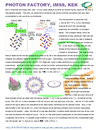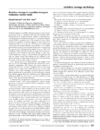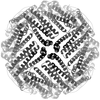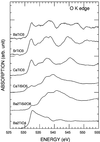issue contents
November 2002 issue
Includes papers presented at the Second International Workshop on X-ray Damage to Crystalline Biological Samples
Chicago, USA, December 2001

Cover illustration: Cryocooling a lysozyme crystal in a 100 K gas stream, see Snell, Judge, Larson and van der Woerd, pages 361-367.
facility information
radiation damage workshop
A short summary of the current state of knowledge regarding radiation damage to crystalline biological specimens is provided, taking into account information provided in recently published papers.
The chemical processes possible when protein crystals suffer radiation damage in an X-ray beam are outlined. Approaches to reducing the damage are discussed from a radiation chemistry viewpoint.
X-ray damage to lipidic mesophases is shown to be free-radical mediated, to involve chemical degradation, to trigger phase transitions and to continue post-irradiation. Dose rate, X-ray energy, beam heating and dispersing-medium effects were investigated. X-ray diffraction is not a reliable indication of radiation damage. This work has relevance to physiological processes, such as aging, that involve oxidative damage.
Changes in disulfide bond lengths upon X-ray irradiation are examined. Together with microspetrophotometric data and quantum chemical calculations, they are found to be indicative of the formation of disulfide radicals.
Unit-cell volume expansion is investigated as a radiation-damage metric in cryocooled protein crystals and found not to be a reliable indicator. The radical scavengers styrene and ascorbate are tested as means of reducing X-ray damage at 100K: styrene is found to be ineffective, but ascorbate is a promising candidate.
The unit-cell volume increase upon radiation damage has been used to study the effect of temperature and X-ray dose rate on crystals of holoferritin. A dose-rate effect has been found, and it is postulated that trapped radicals become mobile at ca 180K.
In this work it is shown for the first time that it is possible to thermally image macromolecular crystals cooled in a 100K nitrogen gas stream.
The temperature, radiation energy and flux dependence on the rate of the change in d-spacing were investigated in order to monitor radiation damage in organic small molecules and protein crystals.
Ultrahigh-resolution data collected from D-xylose isomerase crystals suggest that, when cooled with He rather than N2, these crystals maintain order and that high-resolution data are less affected by increased radiation load. An apparent phase transition in macromolecular crystals between 16 and 100K requires investigation to broaden cryogenic He use.
research papers
A linear-transmission Fresnel-zone-plate lens is used for coupling a monochromatic X-ray beam of 13.2keV into a planar X-ray waveguide. The coherent properties of the beam are investigated by comparing the experimental data with numerical calculations in which partial coherence is taken into account by propagation of the mutual intensity function.
The O K-edge spectra of a series of Ti-bearing compounds with Ti in different structural and chemical environments are measured using electron energy-loss specroscopy and are analyzed using ab initio full multiple-scattering calculations.
computer programs
The Blu-Ice and Distributed Control System software packages unify control over hardware at macromolecular crystallography beamlines and provide a platform for increasing beamline ease of use, automation and remote accessibility.


 journal menu
journal menu




































